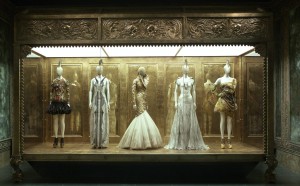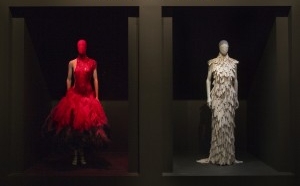From the dark and stormy folds of the mind of Alexander McQueen, to the bright and glorious sun of his vision, the current retrospective at the Met is bar none, one of the most overwhelming exhibits that this writer has ever seen. Not just visual, but aural, the process envelops the participant in an experience. Sensory perception required.
Do it with the earphones if you’re a beginner. Do it with the earphones for the first time you go through it. But the second time, and there must be a second time, do it without the invasive, intrusive appliance that inhibits and restricts. Allow yourself time to taste the atmosphere that is herein created. No skeletons of fashion strutting in vapid surroundings, these mannequins are bedecked in McQueen outfits, and encumbered in hoods/masks that eliminate the element of voyeur. The hoods that dress the mannequins are made by Guido Palau . They run the gamut from subversive B&D leather, to lace ornamentation that show a partial divinity beneath the mere corpus.
 Here’s a tip: do the first room, filled with blouses, jackets, trousers, as a preparatory. See the beginnings and trace the elemental McQueen through his separates. Since most people don’t know how to view an exhibit in a museum anymore, be wary of the crowds, and their distracting commentary. Focus on the fact that here, in this intro room, you can clearly take note of that one twist to a line that magically makes the garment a McQueen. Look at his Jack the Ripper collection, his earliest, and bear in mind that you are about to see evolution in design genius unfold. Not only in the progress of Alexander McQueen’s perspective, but in the layout of the exhibit. The installation progresses once you step through this room, into the world of his true magic. Review some of the elements of early configurations: the Dante, from A/W `1996-7, with all the sturm und drang of the French Revolution embodied in the drape of the “skirt” of the jacket- torn asunder, like the country, still attached by the thinnest thread of gold bullion braid. Such a statement of fact! Who of the press really got this guy in his early days? If not for the eye of Isabella Blow, how fast would McQueen’s rocket have catapulted into the sky? How quickly the flame shoot into the world wide fashion scene?
Here’s a tip: do the first room, filled with blouses, jackets, trousers, as a preparatory. See the beginnings and trace the elemental McQueen through his separates. Since most people don’t know how to view an exhibit in a museum anymore, be wary of the crowds, and their distracting commentary. Focus on the fact that here, in this intro room, you can clearly take note of that one twist to a line that magically makes the garment a McQueen. Look at his Jack the Ripper collection, his earliest, and bear in mind that you are about to see evolution in design genius unfold. Not only in the progress of Alexander McQueen’s perspective, but in the layout of the exhibit. The installation progresses once you step through this room, into the world of his true magic. Review some of the elements of early configurations: the Dante, from A/W `1996-7, with all the sturm und drang of the French Revolution embodied in the drape of the “skirt” of the jacket- torn asunder, like the country, still attached by the thinnest thread of gold bullion braid. Such a statement of fact! Who of the press really got this guy in his early days? If not for the eye of Isabella Blow, how fast would McQueen’s rocket have catapulted into the sky? How quickly the flame shoot into the world wide fashion scene?
The ever precarious balance between good/evil/, and the “dialectical oppositions” herein captured for all the world to see and dissect, mushroom in the second room. Caught in a room that time forgot, the marquetry and surround that frame the “ancient” mirrors…mirrors that reflect all and nothing at all: the Poe side of McQueen, the gothic side of his fashion vocabulary.
Leather ensembles, more masks, hoods , really, that deny women for whom they are, yet celebrate them for being creatures capable of enormous change, with an adaptive facility that leads to and from McQueen’s flights of fancy. McQueen’s “Supercalifragilisticexpialidocious” collection, A/W 2002-3 is herein enhanced via a a separate cubicle, with a wind machine that controls the flight of the coat, fashioned from parachute silk. It billows around the mannequin, projecting the haunting appearance of a ghostly highwayman keeping vigil upon a lonely cliff. It is not a garment, but a soul, abandoned in the twilight that exists between heaven and hell.
 The sounds in this room are nightmarish: every child’s dream of howling wolves, storm-tossed winds, echoes of banshees in the night. It is a chorus of sounds of “the children of the night”, as Bela Lugosi said as “Dracula” .
The sounds in this room are nightmarish: every child’s dream of howling wolves, storm-tossed winds, echoes of banshees in the night. It is a chorus of sounds of “the children of the night”, as Bela Lugosi said as “Dracula” .
As part of the “Eclectic Dissect”, A/W 1997-8, there is silk moiré with black silk lace, black horsehair embroidered with millions of jet beads. Swags of jet beads. Victorian romance bends to the will of Victorian melodrama and gothic might. More from the Dante collection, where McQueen has examined the skirt as bodice, and constructed a corset of lilac silk faille, completely appliquéd with black silk and more jet beads.
Where there any jet beads left in Whitby after this collection, one might ask?
This piece in question stands away from the hips, and creates an elevated “collar to revers, to stand up collar”, as if the medium weren’t enough for his vision: he had to dissect the actual garment and reconstruct it as Dr. Frankenstein did with his monster. But the McQueen monster is goddess, dressed to rule for time immortal.
Leaving the unnatural, dark development of McQueen in Victoriana behind, we are faced with 5 separate guardians to the gates of Hell, or Heaven, in their own gilded cage. The Amazons, as they were in other times and spaces. Jewelled ankle “bracelets” meld into the shoe. The shoe rises from a sole of molten gold, sculpted and cleaved from the forge of a Viking god. This is the digital print collection, with excerpts of ideas divided onto garments, gowns and panels of garments. These stalwart sentinels are also masked, with tinted Mohawks of golds, and dusty blacks that helps to set the “cartoon” quality of each piece. Inspired by Tim Burton, 2002-3, as claimed by the text that follows you throughout the exhibit.
Onto the accessory room, with a mixed overview of jewelry, headwear, shoes and accoutrements that make any fashion collection come to life. From Philip Treacy’s Ramshead, the Horn of Plenty (2009-10), to Dai Rees’ La Poupee pieces, from S/S 1997, this cabinet of Dr. Caligari fills the mind and eye with bits chosen for their impact, and importance. La Dame Bleu, from S/S 2008 is the famous and oft-seen butterfly hat, where Philip takes turkey feathers, paints them to resemble butterflies, and wires them to float aloft, encircling the head in a winged flurry of color. Scupted vertebrae, fantasmajorical leather molded to the bust as corset that encloses head to hip. The shoes, the bags. But this is not stuff to be found in the gift shop as you leave the exhibit. These are indeed museum pieces. Fashion as art, a s we have long heard, to be viewed, appreciated, yearned for, and indeed, worn by a lucky few. This room, with it’s shelves of accessories is a total representation of the wonderous high flying mind of Alexander Mc Queen, as he filled in the blanks of each collection.
 Now, step into the royal tomb, where gilded, facetted masks cover the heads of the mannequins herein. Candelabra cast a golden light, and the “Romantic Nationalism” collection lays itself at your feet. On one side, the dead semblances of Empresses and Queens flutter in their chiffons. On the other side, the Tartan collection applauds the legacy of womankind: their bodies, shapes, legacies. Appliquéd plaids balance with the pleated creams of the underskirts, taking into consideration the innocence of the inherent visualization and McQueen’s pristine attention to historic detail.
Now, step into the royal tomb, where gilded, facetted masks cover the heads of the mannequins herein. Candelabra cast a golden light, and the “Romantic Nationalism” collection lays itself at your feet. On one side, the dead semblances of Empresses and Queens flutter in their chiffons. On the other side, the Tartan collection applauds the legacy of womankind: their bodies, shapes, legacies. Appliquéd plaids balance with the pleated creams of the underskirts, taking into consideration the innocence of the inherent visualization and McQueen’s pristine attention to historic detail.
From his “Widows” to his “Highland Rape “(1995-6), piece after piece attemps to cry out loud for all design, past, present and future that wants to live as not just a garment on a hanger in the forgotten wardrobe of the rich, but as embodiments of a society that celebrates it’s collective strains of elemental tracing.
A hologram of the final piece captures and captivates: Kate Moss in tiny 3D, which was the finale to “Widows “ in 2006-7. The hologram is projected in the center of a cubicle, with slots as viewing windows for the public. Try to see the entire run of this projection, for the beauty, for the dynamic, and the experience will only add more layers to the dimensions of McQueen.
Romantic Exoticism in the last hallway underlines his atypical application of fantasy fabrics. We have here Geishas in new, fanciful combos: 18th Century coats made of kimono fabrics. Geisha boleros. An obi, traditionally worn as a cinch to the waist of a formal kimono, is here used as a train for a cocktail dress. Alexander McQueen pulls design references and combines them in the circus atmosphere of his dark and cloudy mind. The resulting vision precludes fashion as definitive, fashion as predictability, fashion as formula. Anarchy lives in McQueen, where he is the child of Vivienne Westwood and Edgar Allen Poe, lost in the ulterior weirdness that was his imagination.
 Not done yet! Now, onto Romantic Primitivism: It’s a Jungle Out There, for A/W 1997-98 includes horns, leather, burlap. For the purists and the PETAS, in this heavily animal- doused collection, Alexander McQueen said” none were killed for their fur. They have all been killed for their meat.” So the quote goes, as pacification to the animal worried. For 2000-2001, horsehair, beads, Masai, mud comes into play as aesthetic and collection. Inspiration from the native, and allowing the actual mud to cake on a chiffon gown shows us the true boy behind the label: play time had to happen once in a while, and yet it resulted in a fabulous juxtaposition of materials. Chiffon and mud: who would have thought of it? Shipwreck and oyster balance, two nymphs left alone on an island to fend for themselves: just them and their silk chiffon.
Not done yet! Now, onto Romantic Primitivism: It’s a Jungle Out There, for A/W 1997-98 includes horns, leather, burlap. For the purists and the PETAS, in this heavily animal- doused collection, Alexander McQueen said” none were killed for their fur. They have all been killed for their meat.” So the quote goes, as pacification to the animal worried. For 2000-2001, horsehair, beads, Masai, mud comes into play as aesthetic and collection. Inspiration from the native, and allowing the actual mud to cake on a chiffon gown shows us the true boy behind the label: play time had to happen once in a while, and yet it resulted in a fabulous juxtaposition of materials. Chiffon and mud: who would have thought of it? Shipwreck and oyster balance, two nymphs left alone on an island to fend for themselves: just them and their silk chiffon.
There is yet a soft side to Alexander McQueen. Leave aside the dark and the brooding, the outré and the wild, and you have Sarabande: silhouettes with flowers, and dripping tulle. The harder side comes into play with the structure: corsets, hoopskirts, antlers. Washed, blended colors meld onto these hard shapes to create a magnificent poetic license. As if the woman were melting into her very being. 2007. A feathered gown, a wedding gown, completely the lace heroine, or a gown covered in flowers, both dried and silk, combine to provide an alternate world to that which follows: Romantic Naturalism, embodied by Plato’s Atlantis S/S 2010.
From the depths of Hellfire, and the nymphs of the wood. To the drawing rooms of the elite aristos and the firebrands of political upheaval, McQueen has left us a complete vocabulary for woman. Here now, the sea goddess: half creature, half human. The lifeblood of the future race of man. Underwater pointillism captured in enamelled palettes, patterns (coral reefs, jelly fish), snakes, honeycombs, armdillo hides. This is the collection where McQueen predicts the future. Man devolves and evolves back to the sea, as a creature who mimics his origins. The famous shoe/boot collection from this season needs to be seen in context to appreciate fully the design development and reference.
It all marries perfectly, and is a show to remember. Don’t just buy the book. There won’t be a movie. See the show in this last week of it’s presence in NYC’s Metropolitan Museum. Opening late hours to accommodate the crowds (until midnight on the final evenings).
Many pieces in this retrospective are from the collection of the late Isabella Blow, thanks to the forward thinking of Daphne Guinness, who saved Izzy’s estate.
If your thinking about seeing this exhibit (it’s definitely worth going!), make sure you get to The Met soon as it’s only going to be there until Aug 7th, 2011! For more information, visit their website.



Fantastic Site…
[..] I Stumbled accross this great blog post and guessed you fans would like it.[..]…
Great post!!
Fantastic Site…
[..] I Stumbled accross this neat post and guessed you guys would love it.[..]…
This is an amazing post!!
Thank you for your comment, and the praise. We aim to please!